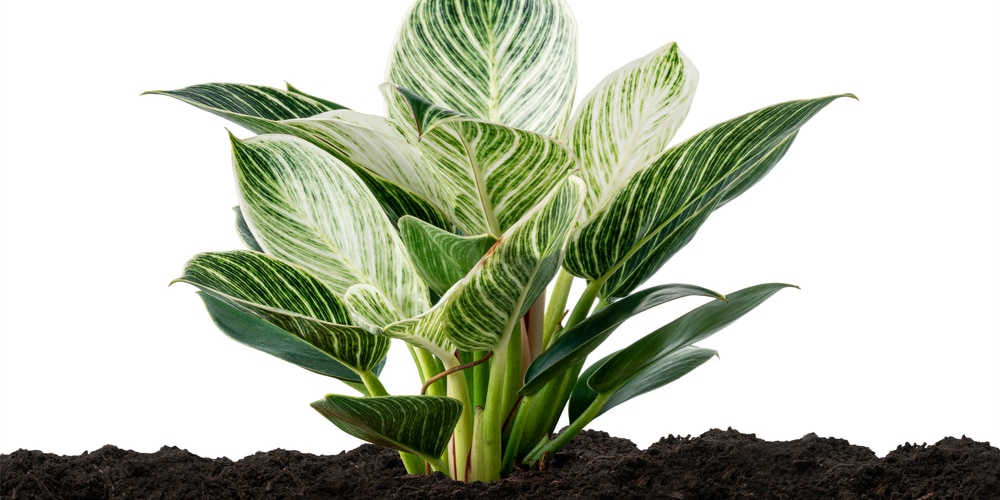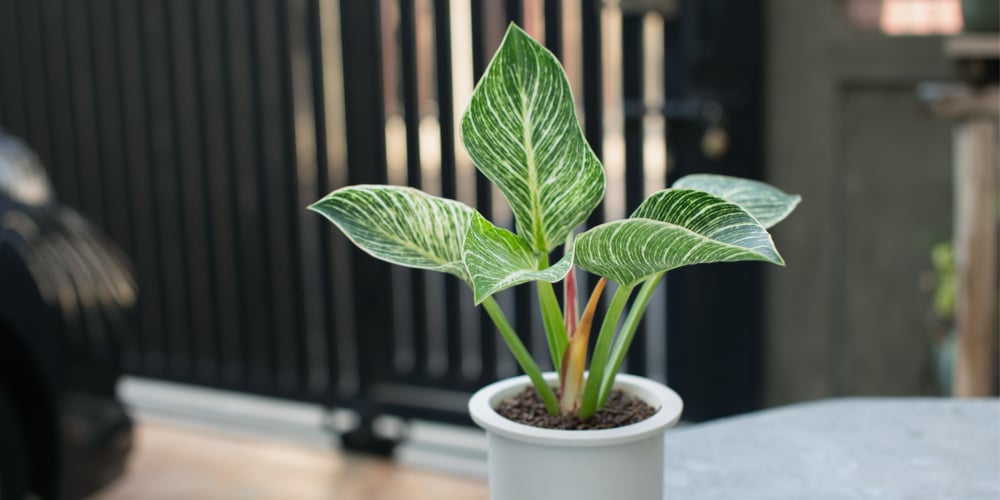Philodendron Birkin’s are tropical evergreen houseplants with rare variegation. These beautiful plants have thick, leathery foliage that’s dark green with cream markings. As Philodendron Birkin plants are pretty compact, they make a great houseplant choice and are popular worldwide.
Philodendron Birkin’s are easy to look after, but they do have some specific care requirements. These plants originate from tropical regions of South America, particularly the Brazilian rainforests, but can adapt well to cooler climates. They can even be grown outdoors in USDA zones 9 to 11. Let’s look at how to grow and care for a Philodendron Birkin plant.
What is a Philodendron Birkin Plant?

The Philodendron Birkin has glossy leaves that start off lime-green and yellow and darken as they mature. These plants have cream variegation and dark green leaves. The pattern is rare and not found on many other species of philodendron. Each leaf has slightly different markings, and the leaves can even change color.
Philodendron Birkin plants have pointed oval leaves and are flowering plants. The species is one of the philodendron family that doesn’t grow vines; this makes it a compact plant that won’t spread and take up much space in the home. The plants are pretty fast-growing; they reach 3 feet tall at maturity. How fast your plant will grow depends on the environment and the size of the pot.
It’s Rare and Expensive
In the past, the Philodendron Birkin was very rare and expensive. Nowadays prices have dropped slightly as the plant’s popularity and numbers have increased. However, it is still considered an unusual plant that is highly sought-after by plant enthusiasts.
- LIVE INDOOR PLANT: A rare and highly sought-after plant, the Philodendron Birkin's unique patterned leaves will make a stunning addition to any collection
- PLANTS MAKE YOU FEEL BETTER: Seeing greenery and nature in our rooms, desks, and offices help us feel more relaxed and calm. NASA studies show having plants in your home improves your mood, sparks your creativity and reduces...
- FRESH FROM FARM: Every plant is packed with utmost care and arrives direct from our farm to your home. Each plant has been grown to the highest quality standards so that you receive a healthy indoor plant
- BEAUTIFUL HOME DECOR: With their striking green and white foliage, Philodendron Birkin plants are sure to add a touch of natural elegance to any room, making them a must-have for any interior design enthusiast
- CLEANER AIR: Philodendron Birkin plants have been shown to purify the air in your home, providing a cleaner and healthier living environment
It’s Poisonous
Like many tropical houseplants, the Philodendron Birkin is poisonous if ingested. The plants leave contain a substance called calcium oxalate, which is toxic to cats and dogs. It would help if you were careful when handling the plant as it contains a sap that can cause skin irritation, leading to a painful swollen rash.
Caring for a Philodendron Birkin
The Philodendron Birkin is easy to care for, and the plant will thrive as long as its basic needs are met. Here are some tips to help you grow a thriving Philodendron Birkin plant.
Sunlight Requirements
Philodendron Birkin plants should be placed in bright indirect sunlight. In its natural rainforest habitat, the plant grows in dappled light as its overshaded by larger trees. Please don’t leave your plant in the full sun, or it will suffer. You may find that the leaves get sunburnt or the color of the foliage is affected. Too much light can fade the leaves, while not enough will make leaves lose their variation and turn dark green.
Soil
It’s best to grow Philodendron Birkin plants in well-aerated soil that’s loose and well-draining. You can mix some peat moss and perlite into a standard houseplant pre mix. Alternatively, choose a soil mix that’s been designed specifically for tropical plant species.
It’s best to use peat moss soil as it can retain moisture yet also aerates the soil. Perlite helps to reduce drainage issues and means your plant will be less likely to become waterlogged.
Watering Requirements
Tropical houseplants can be watered using the ‘soak and dry method. This means you can drench your plant and then wait until the top one or two inches of soil have dried out completely before watering again. It’s best to use rainwater or filtered water for tropical plants as the Philodendron Birkin is fairly sensitive and can be affected by chlorine and other chemicals. It’s also a good idea to use water that’s at room temperature so as not to shock the plant.
Temperature Needs
Philodendron Birkin can thrive in the average home, which has a temperature of between 60°F and 75°F. Be careful not to leave your plant in a draft from an open window or air conditioning unit. You should also keep the plant away from direct heat.
Humidity
As a tropical plant, Philodendron Birkin’s require enough humidity to thrive. Aim to get the humidity to between 40 and 70 percent. If the humidity is too low, the tips of your plant’s leaves may turn brown. That being said, these plants are fairly adaptable and can survive in areas of lower humidity.
To increase the humidity surrounding your plant, you can try misting or use a tray that contains stones and water. Group your tropical plants together and place the tray underneath. This will help boost the air moisture surrounding your plants. Alternatively, you may like to invest in a humidifier. We have an entire guide dedicated to Philodendron humidity if you wish to learn more.
Fertilizer
It’s best to use a liquid-based fertilizer once a month. Many plant experts recommend diluting standard fertilizer to about half strength for tropical plants. It’s best to use a fertilizer with an NPK rating of 20-20-20. If you’re looking for an organic houseplant fertilizer, you can try adding worm casting to the soil next time you repot your plant.
Pests
Philodendron Birkin is considered fairly pest resistant but is sometimes affected by mealybugs and spider mites. You can use neem oil or an insecticidal spray to get rid of any insect pests. It’s best to take action and get rid of pests as soon as you notice signs of hitchhikers. Wiping the leaves or using a spray will reduce the chance of an insect infestation.
Disease
Philodendron Birkin can be affected by fungal disease, which is particularly common in plants that have been regularly overwatered. Excess water that isn’t able to drain away will cause root rot.
Fungal infections can cause dark spots to appear on the foliage, and your plant may look weak or begin to wilt. Correct watering will reduce the chance of your plant developing a fungal infection. If your plants showing signs of fungal infection, you can prune off the damaged leaves and treat your plant using fungicide.
Conclusion
Philodendron Birkin plants are beautiful tropical houseplants that have unique and eye-catching leaves. These plants are relatively easy to care for, but you need to get the basics right, or their leaves may fade or even turn completely green.
Philodendron Birkin’s should be watered when their topsoil has dried out. They are best grown in bright indirect sunlight and thrive at average house temperature. Another popular Philodendron is the Cordatum variety, which makes a great houseplant.
Last update on 2025-06-06 / Affiliate links / Images from Amazon Product Advertising API

